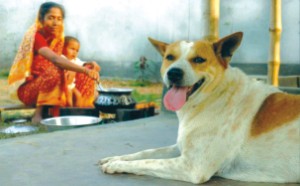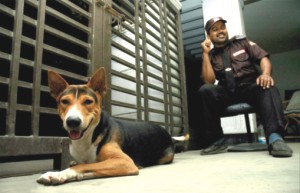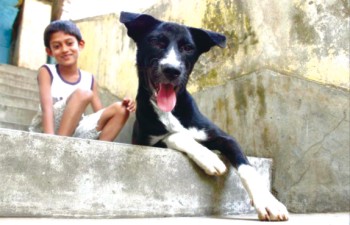| Endeavour
A Sanctuary for Them
The greatness of a nation and its moral progress can be judged by the way its animals are treated – Mahatma Gandhi; Obhoyaronno-Bangladesh Animal Welfare Society (BAWS), with Gandhi's motto at heart, has pioneered to teach and raise awareness about aptly treating the canine, bovine, feline cohabitants around us.
AANTAKI RAISA
Photos: Obhoyaronno
"Six killed, 38 injured in road accident”, “26 killed in factory fire”, “four killed in 'shootout'”, “Over 700 killed in cyclone Sidr”- when newspapers of Bangladesh are filled with devastating and horrifying news of violence against humanity, topics like “treat the animals well” or “stop inhuman dog-culling” do not make headlines, do not even ring a bell.
 |
“She is one of my family members, I don't cook for her separately” – Masuda Begum, Khulna. |
Bangladesh, as a people, has witnessed and been victims of so much violence, that it has turned immune to any sort of cruelty or torture. They are so busy coping with their own troubles, they have no time or empathy for the “inferior” species. That is perhaps the reason why we see children throwing stones at bird-nests, teenagers enjoying the misery of a cat having its tail sliced or people doing nothing about or even laughing at dogs being brutally culled. We seem to have lost our humane touch. Proving wrong all such notions, Obhoyaronno, the first ever animal welfare organisation in Bangladesh, has come forth to help, provide care to the neglected non-human populace around.
“It would be wrong to say that Bangladeshis are cruel to animals. You'd see a dog or a cat in almost every family in the rural area; they are treated as family members there. You'd see a dog accompanying a night-guard in the suburbs. The wealthy class spends a good amount of money on buying and nurturing their, often imported, pets. It's the middle class of the urban locale who are immune to and sometimes causes of animal abuse,” says Rubaiya Ahmad, founder and CEO of Obhoyaronno. Obhoyaronno-Bangladesh Animal Welfare Society (O-BAWS) is a non-profit organisation, working to abolish animal cruelty in Bangladesh since 2009. Their areas of work include welfare of small companion animals, humane treatment of livestock animals, wildlife preservation, prevention of illegal animal trades etc. “Protection and preservation of wild animals is a recent topic in Bangladesh. But while we talk about the welfare of the animals we barely interact with (such as tigers, monkeys, deer) we neglect to talk about those who live with and around us (like dogs, cats, domestic animals). We hardly recognise their existence and when we do notice them, we treat them as pests,” claims Ahmad.
Within only a year of formation, Obhoyaronno has collaborated with Dhaka City Corporation (DCC), Central Veterinary Hospital and some other governmental and non-governmental organisations to achieve their goal. “We started with protecting dogs, first of all because we needed to start with something. And dogs were the best choice because they are killed and tortured the most,” Ahmad explains about Obhoyaronno's endeavour on 'Stop Dog Culling'. While talking about their act against dog culling, Ahmad says that dogs are culled in Bangladesh due to the myth that this is the only way to get rid of rabies. But, dog culling has been going on for about two decades and still it has not prevented people dying from rabies every year. This is a practical proof that extermination of dogs is no solution to preventing rabies. An infected dog can be put down in a humane manner. At present, both infected and non-infected dogs are captured using large iron tongs to grab their necks and are then dragged into trucks. Once inside, the tongs are twisted to break their necks. Not only does this cause unbearable pain, it is sadism taken to an extreme. People stand by and watch the dogs crying and screaming in agony and they do absolutely nothing.
 |
 |
“I have been photographed many times, now it's his turn” – Md Idris Ali, Village Marketeer, Rajshahi. |
“He too stays up all night with me” – Anwar Hossain, Nightguard. |
This kind of brutality is completely unnecessary because dogs are fast breeding mammals and no matter how many of them are killed, they will always keep increasing in number. The logical and scientific approach here would be to try and control the canine birth rate by implementing Animal Birth Control (ABC) mechanism. If the population decreases, it will be easier to vaccinate the dogs so that they do not spread or remain prone to rabies. Obhoyaronno is currently working on realising this project. “We are planning to start with a dog census in Dhaka city's 26 wards. Then we will collect the dogs, vaccinate all of them and sterilise the female dogs, so that they cannot reproduce. Thus we can bring the dog population under control and consequently reduce the spread of rabies, ” explains Ahmad.
 |
“Tiger is my best friend” – Supto, Science Laboratory, Dhaka . |
And it's not just the dogs we are mean to; our cruelty torments cats, cows, goats, birds, frogs and what not! And Obhoyaronno plans to take initiatives to raise awareness for all of them. Ahmad says that social scientists, policymakers and law enforcement finally agree that cruelty to animals hosts a web of violence and crime in our communities. Many studies in psychology, sociology, and criminology during the last 25 years have demonstrated that violent offenders frequently have childhood and adolescent histories of serious and repeated animal cruelty. The FBI has recognised the connection since the 1970s, when its analysis of the lives of serial killers suggested that most had killed or tortured animals as children. Other research has shown consistent patterns of animal cruelty among perpetrators of more common forms of violence, including child abuse, spouse abuse, and abuse of the elderly. In fact, the American Psychiatric Association considers animal cruelty one of the diagnostic criteria of conduct disorder. “Children can be manipulated easily. It's the adults who are hard to be made understood about the importance of being nice and caring towards animals,” adds Ahmad. They may have no voice to protest or stand up for their rights, but this does not mean that they don't feel pain or hurt just like we do. It is because they are helpless that we should extend a helping hand.
Obhoyaronno's message is already spreading, especially among the youth. Hands and Paws, an animal-loving students' group from the American International School, has started their own animal-adoption programme where homeless, orphaned animals are provided with shelters and host families. Obhoyaronno is building its own animal shelter; the vehement animal lover Ahmad states on Obhoyoronno's further projects, “I look forward to the day when Obhoyaronno and organisations like ours won't be needed anymore; because people will love and care for animals willingly and there won't be any need to teach them.”
Copyright
(R) thedailystar.net 2010 |
|
